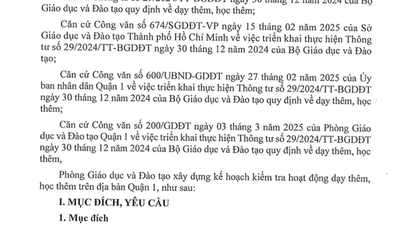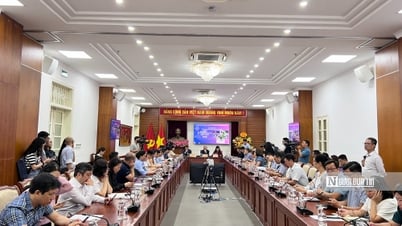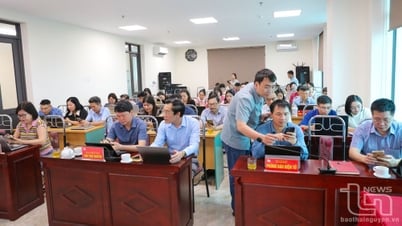The General Department of Taxation said that on February 15, this unit issued Official Dispatch No. 525/TCT-DNNCN on tax management for business households and business individuals (HKD, CNKD), accordingly requesting the Tax Departments of provinces and centrally run cities to: direct the review of subjects in the area to avoid missing households, organize surveys of revenue and factors related to the actual business activities of business households; review and standardize personal tax registration information, including information of business household owners; review the database on the Electronic Information Portal provided by e-commerce trading floors; strengthen the implementation of electronic invoices for business households, especially strengthen coordination with local agencies and departments to continue managing and expanding the implementation of electronic invoices generated from cash registers.
In order to continue strengthening tax management for business households and individuals, the General Department of Taxation requests the Directors of Tax Departments of provinces and centrally-run cities to direct attention to the following contents:
First, on propaganda work to support taxpayers.
Strengthening propaganda and support for taxpayers on the implementation of tax policies and laws for business households and business individuals. In particular, guiding business households and business individuals to register for tax, declare tax, and pay tax according to the law, focusing on guiding some contents that the tax sector has implemented to modernize tax management for business households and business individuals such as: supporting electronic tax at level 4.0 in the entire tax management process (tax registration, tax declaration, tax payment); supporting information lookup on tax obligations on the Etax Mobile application; deploying the Digital Business Household Map function to publicize information of business households and business individuals paying lump-sum tax and supporting information feedback to tax authorities on tax management for business households and business individuals; applying electronic invoices to the entire economy including business households and business individuals, etc.
Second, on the management of business households and individual businesses.
Organize the review of all tax management records for business households and business establishments (including operating, temporarily suspended, absconding, etc.) in the management area; promptly handle cases of improper implementation of tax management regulations for business households and business establishments.
Organize comparison and review in the management area to grasp the situation of fluctuations in business activities of business households and businesses and promptly put them into management according to regulations.
Compare with information sources of relevant state agencies (Statistical agencies, Business registration agencies, Local authorities, etc.) to compare the number of business households and business entities managed in the area, specifically determine the cause of the difference, ensure that the data between state management agencies is consistent with the actual occurrence, thereby fully managing all business households and business entities actually operating, ending the situation of having business households and business entities but not establishing a Tax Department.
After checking and verifying at the locality and comparing with information sources of relevant state agencies, if the business household or business entity has been established by the tax authority but is no longer doing business in the locality, the tax authority shall handle the case in accordance with legal regulations and regulations at point 3.6, clause 3, section II, part II of the Tax management process for business individuals issued together with Decision No. 2371/QD-TCT dated December 18, 2015 of the General Director of the General Department of Taxation.
Provide the business registration authority with information on registered business households and business entities that are no longer operating at the registered business address so that the business registration authority can carry out management according to regulations.
Publicly disclose information on business households and business individuals paying lump-sum taxes according to regulations, and at the same time publicly disclose it on the Business Household Number Map function according to the directives of the Ministry of Finance and the General Department of Taxation, ensuring transparency and enhancing the monitoring capacity of people and agencies, departments and local authorities.
Third, on inspection and supervision work.
Organize regular review and survey of revenue and lump-sum tax rates, compare separate databases, input invoice databases of lump-sum households and actual business situation in the area to re-evaluate revenue and lump-sum tax rates of business households and business enterprises. From there, adjust revenue and lump-sum tax rates to match actual occurrence, ensuring consistency with localities, provinces and cities nationwide.
Organize the implementation of tax management inspections for business households and business individuals at the Tax Department according to the plan and thematically as guided in Clause 4, Article 18 of Circular No. 40/2021/TT-BTC dated June 1, 2021 of the Ministry of Finance, specifically: (i) conduct annual physical inspections of at least 10% of the Tax Departments according to regulations on risk management for determining the expected lump-sum revenue and expected lump-sum tax; (ii) periodically conduct physical inspections of at least 5% of the Tax Departments each quarter I, II, and III; (iii) The content of the physical inspection includes: inspection on the management database; comparison of business registration and tax registration data; physical inspection of at least 2% of business households, business individuals and related organizations in the area, focusing on inspecting 100% of business households and business individuals subject to high-risk management as prescribed.
Direct the Tax Branches to conduct periodic and planned inspections at the tax authority's headquarters based on the database of business households, business individuals and related organizations. In high-risk cases with signs of violations, inspections shall be conducted at the taxpayer's headquarters to promptly detect and prevent violations of tax and tax management laws.
Fourth, on consulting with local authorities.
Advise the Provincial and Municipal People's Committees to direct relevant state agencies (Business Registration, Statistics, Finance, Banking, Industry and Trade, Market Management, Police, Information and Communications, etc.) to coordinate with tax authorities to regularly compare and review in the area to grasp the situation of fluctuations in business activities of business households and business enterprises to serve tax management work according to regulations.
TM
Source











































































































Comment (0)